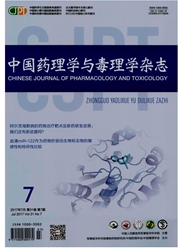

 中文摘要:
中文摘要:
目的:探讨雌激素受体(ER)途径在双酚 A(BPA)诱导的大鼠胚胎中脑微团细胞存活和分化抑制效应中的作用。方法制备的胎龄13 d 大鼠胚胎中脑微团细胞,以 BPA 10-4,10-6,10-8,10-10和10-12 mol·L -1染毒5 d,中性红摄取实验检测细胞存活,苏木精染色检测中脑细胞集落分化总面积。BPA 0.1 mmol·L -1+雌激素受体抑制剂 ICI1827800.1 n mol·L -1、BPA 0.1 mmol·L -1+雌激素受体抑制剂他莫西芬1 n mol·L -1共同培养5 d,检测中脑微团细胞存活和集落分化总面积。Western blot 法检测胎龄18 d大鼠胚胎脑组织、成年大鼠的睾丸和未染毒中脑微团细胞 ER 蛋白的表达。实时定量 PCR 法检测胎龄13和18 d 胎鼠脑组织、成年大鼠的睾丸及卵巢、未染毒中脑微团细胞中 ER mRNA 的表达水平。采用实时定量 PCR 法检测 BPA 0.1 mmol·L -1染毒5 d 的中脑微团细胞中 Notch1和 Hes1 mRNA 表达水平。结果BPA 0.1 mmol·L -1可以明显的抑制原代培养中脑微团细胞的存活和集落分化,但此效应不能被 ICI182780和他莫西芬逆转。正常的胎鼠脑组织和未染 BPA 中脑细胞中 ER 蛋白和 mRNA 的表达水平较低。BPA 0.1 mmol·L -1可以明显增加 Notch1和 Hes1 mRNA 表达水平。结论BPA 可抑制中脑微团细胞的的存活和分化,ER 途径在此效应中不发挥主要作用,Notch-Hes 信号通路可能参与了这一效应。
 英文摘要:
英文摘要:
OBJECTIVE Study the role of estrogen receptor (ER)in the inhibition of cell viability and differentiation induced by bisphenol A (BPA)in micro mass culture of rat e mbryonic midbrain(MB) cells.METHODS Micro mass cultures of MB were prepared fro m rat e mbryonic midbrain on gestation day 13.MB cells were exposed to BPA (10 -4 ,10 -6 ,10 -8 ,10 -10 ,10 -12 mol·L -1 )for 5 d.Cell viability was assessed by neutral red uptake test.MB differentiation was detected by he matoxylin staining and i mage analysis.In order to observe the role of ER pathway in the toxicity induced by BPA,cell cultures were co-treated with ICI182780 0.1 n mol·L -1 ,ta moxifen 1 n mol·L -1 and BPA 0.1 mmol·L -1 for 5 d, the cell viability and foci differentiation were detected.Moreover,the protein expression levels of ER in normal e mbryonic brain of gestation day 18,testis tissue fro m adult rats and midbrain cells untreated with BPA were investigated by Western blot.The mRNA expression levels of ER in normal e mbryonic brain of gestation day 13 and gestation day 18,ovary and testis tissue fro m adult rats,and midbrain cells un-treated with BPA were investigated by real-ti me PCR.The mRNA expression levels of Notch1 and Hes1 in MB cells treated with BPA 0.1 mmol·L -1 were also detected by real-ti me PCR.RESULTS BPA 0.1 mmol·L -1 could inhibited MB cell viability and foci differentiation.However,this effect could not be reversed by ER antagonist.The protein and mRNA expression levels of ER in e mbryonic brain and MB cells untreated with BPA were found to be extre mly low.In addition,BPA 0.1 mmol·L -1 could inhibited the mRNA expression levels of Notch1 and Hes1 .CONCLUSION BPA could inhibited MB cell viability and foci differentiation.ER pathway might be not involved in this effect.Instead,Notch-Hes pathway might be involved for this effect.
 同期刊论文项目
同期刊论文项目
 同项目期刊论文
同项目期刊论文
 Bisphenol A inhibits proliferation and induces apoptosis in micromass cultures of rat embryonic midb
Bisphenol A inhibits proliferation and induces apoptosis in micromass cultures of rat embryonic midb 期刊信息
期刊信息
